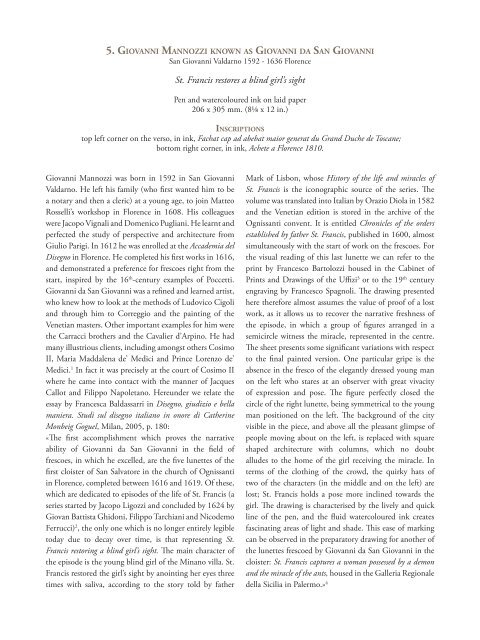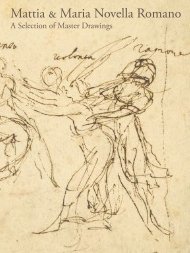A Selection of master drawings 2014
- No tags were found...
Create successful ePaper yourself
Turn your PDF publications into a flip-book with our unique Google optimized e-Paper software.
5. Giovanni Mannozzi known as Giovanni da San Giovanni<br />
San Giovanni Valdarno 1592 - 1636 Florence<br />
St. Francis restores a blind girl’s sight<br />
Pen and watercoloured ink on laid paper<br />
206 x 305 mm. (8⅛ x 12 in.)<br />
Inscriptions<br />
top left corner on the verso, in ink, Fachat cap ad abebat maior generat du Grand Duche de Toscane;<br />
bottom right corner, in ink, Achete a Florence 1810.<br />
Giovanni Mannozzi was born in 1592 in San Giovanni<br />
Valdarno. He left his family (who first wanted him to be<br />
a notary and then a cleric) at a young age, to join Matteo<br />
Rosselli’s workshop in Florence in 1608. His colleagues<br />
were Jacopo Vignali and Domenico Pugliani. He learnt and<br />
perfected the study <strong>of</strong> perspective and architecture from<br />
Giulio Parigi. In 1612 he was enrolled at the Accademia del<br />
Disegno in Florence. He completed his first works in 1616,<br />
and demonstrated a preference for frescoes right from the<br />
start, inspired by the 16 th -century examples <strong>of</strong> Poccetti.<br />
Giovanni da San Giovanni was a refined and learned artist,<br />
who knew how to look at the methods <strong>of</strong> Ludovico Cigoli<br />
and through him to Correggio and the painting <strong>of</strong> the<br />
Venetian <strong>master</strong>s. Other important examples for him were<br />
the Carracci brothers and the Cavalier d’Arpino. He had<br />
many illustrious clients, including amongst others Cosimo<br />
II, Maria Maddalena de’ Medici and Prince Lorenzo de’<br />
Medici. 1 In fact it was precisely at the court <strong>of</strong> Cosimo II<br />
where he came into contact with the manner <strong>of</strong> Jacques<br />
Callot and Filippo Napoletano. Hereunder we relate the<br />
essay by Francesca Baldassarri in Disegno, giudizio e bella<br />
maniera. Studi sul disegno italiano in onore di Catherine<br />
Monbeig Goguel, Milan, 2005, p. 180:<br />
«The first accomplishment which proves the narrative<br />
ability <strong>of</strong> Giovanni da San Giovanni in the field <strong>of</strong><br />
frescoes, in which he excelled, are the five lunettes <strong>of</strong> the<br />
first cloister <strong>of</strong> San Salvatore in the church <strong>of</strong> Ognissanti<br />
in Florence, completed between 1616 and 1619. Of these,<br />
which are dedicated to episodes <strong>of</strong> the life <strong>of</strong> St. Francis (a<br />
series started by Jacopo Ligozzi and concluded by 1624 by<br />
Giovan Battista Ghidoni, Filippo Tarchiani and Nicodemo<br />
Ferrucci) 2 , the only one which is no longer entirely legible<br />
today due to decay over time, is that representing St.<br />
Francis restoring a blind girl’s sight. The main character <strong>of</strong><br />
the episode is the young blind girl <strong>of</strong> the Minano villa. St.<br />
Francis restored the girl’s sight by anointing her eyes three<br />
times with saliva, according to the story told by father<br />
Mark <strong>of</strong> Lisbon, whose History <strong>of</strong> the life and miracles <strong>of</strong><br />
St. Francis is the iconographic source <strong>of</strong> the series. The<br />
volume was translated into Italian by Orazio Diola in 1582<br />
and the Venetian edition is stored in the archive <strong>of</strong> the<br />
Ognissanti convent. It is entitled Chronicles <strong>of</strong> the orders<br />
established by father St. Francis, published in 1600, almost<br />
simultaneously with the start <strong>of</strong> work on the frescoes. For<br />
the visual reading <strong>of</strong> this last lunette we can refer to the<br />
print by Francesco Bartolozzi housed in the Cabinet <strong>of</strong><br />
Prints and Drawings <strong>of</strong> the Uffizi 3 or to the 19 th century<br />
engraving by Francesco Spagnoli. The drawing presented<br />
here therefore almost assumes the value <strong>of</strong> pro<strong>of</strong> <strong>of</strong> a lost<br />
work, as it allows us to recover the narrative freshness <strong>of</strong><br />
the episode, in which a group <strong>of</strong> figures arranged in a<br />
semicircle witness the miracle, represented in the centre.<br />
The sheet presents some significant variations with respect<br />
to the final painted version. One particular gripe is the<br />
absence in the fresco <strong>of</strong> the elegantly dressed young man<br />
on the left who stares at an observer with great vivacity<br />
<strong>of</strong> expression and pose. The figure perfectly closed the<br />
circle <strong>of</strong> the right lunette, being symmetrical to the young<br />
man positioned on the left. The background <strong>of</strong> the city<br />
visible in the piece, and above all the pleasant glimpse <strong>of</strong><br />
people moving about on the left, is replaced with square<br />
shaped architecture with columns, which no doubt<br />
alludes to the home <strong>of</strong> the girl receiving the miracle. In<br />
terms <strong>of</strong> the clothing <strong>of</strong> the crowd, the quirky hats <strong>of</strong><br />
two <strong>of</strong> the characters (in the middle and on the left) are<br />
lost; St. Francis holds a pose more inclined towards the<br />
girl. The drawing is characterised by the lively and quick<br />
line <strong>of</strong> the pen, and the fluid watercoloured ink creates<br />
fascinating areas <strong>of</strong> light and shade. This ease <strong>of</strong> marking<br />
can be observed in the preparatory drawing for another <strong>of</strong><br />
the lunettes frescoed by Giovanni da San Giovanni in the<br />
cloister: St. Francis captures a woman possessed by a demon<br />
and the miracle <strong>of</strong> the ants, housed in the Galleria Regionale<br />
della Sicilia in Palermo.» 4





